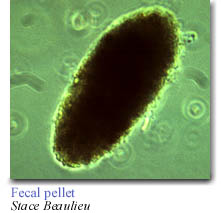![]() hat
happens to diatoms when they die?
hat
happens to diatoms when they die?
 When
a diatom dies, its shell begins a journey towards the seafloor, sometimes
reaching this destination, and other times dissolving back into the seawater
before it lands. Individual diatom shells are so small that in calm waters
they might take a few months or more to settle to the seafloor. However,
there are several ways that diatoms hitch a faster ride down.
When
a diatom dies, its shell begins a journey towards the seafloor, sometimes
reaching this destination, and other times dissolving back into the seawater
before it lands. Individual diatom shells are so small that in calm waters
they might take a few months or more to settle to the seafloor. However,
there are several ways that diatoms hitch a faster ride down.
Many diatoms end up falling to the seafloor in large groups. As a bloom ends when nutrient supplies delivered by upwelling cease, many diatoms die, forming large aggregations which fall much more quickly to the seafloor than individuals. This cycle is similar to the life of grasses in the dry western states. You may have seen grasses or wildflowers green-up a brown hillside in response to welcome spring rains. These plants grow quickly, bloom for a short while, run out of water, and are dead and brown by summer. On land, the dry plant materials fall to the ground. In the ocean, they begin a journey to the seafloor. Larger individuals may also fall more quickly than the small ones.
There is yet another way for diatoms to travel to the seafloor. Some diatoms are eaten by grazers and the munched indigestible shells are packaged into relatively large fecal pellets. Since the fecal pellets are much larger than the original shells, they are able to fall to the seafloor in a matter of weeks rather than hundreds of years. Since it takes a while for diatoms to drop to the seafloor, other organisms don't miss this opportunity to snack on diatoms.
Fecal material and other aggregates of biogenic material sinking through the water column are known as marine snow. As the name implies, to an observer on the seafloor under productive surface waters, settling marine snow might look very much like a snowstorm on land, at night!

